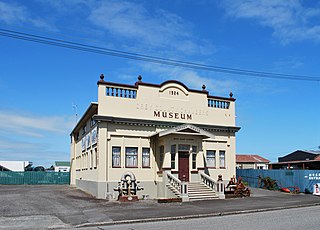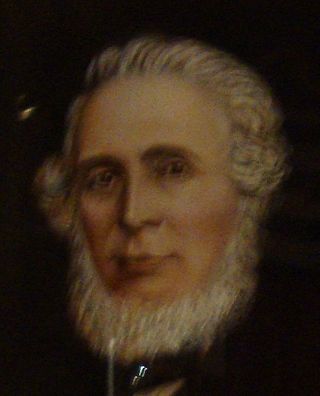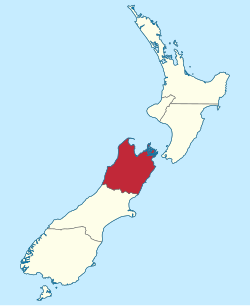
The provinces of the Colony of New Zealand existed as a form of sub-national government. Initially established in 1846 when New Zealand was a Crown colony without responsible government, two provinces were first created. Each province had its own legislative council and governor. With the passing of the New Zealand Constitution Act 1852 the provinces were recreated around the six planned settlements or "colonies". By 1873 the number of provinces had increased to nine, but they had become less isolated from each other and demands for centralised government arose. In 1875 the New Zealand Parliament decided to abolish the provincial governments, and they came to an end in November 1876. They were superseded by counties, which were later replaced by territorial authorities.
The 2nd New Zealand Parliament was a term of the Parliament of New Zealand. It opened on 15 April 1856, following New Zealand's 1855 election. It was dissolved on 5 November 1860 in preparation for 1860–61 election. The 2nd Parliament was the first under which New Zealand had responsible government, meaning that unlike previously, the Cabinet was chosen by Parliament rather than by the Governor-General of New Zealand.

The Marlborough Province operated as a province of New Zealand from 1 November 1859, when it split away from Nelson Province, until the abolition of provincial government in 1876.

The Westland Province was a province of New Zealand from 1873 until the abolition of provincial government in 1876. The capital was Hokitika.

Arthur Penrose Seymour was a 19th-century New Zealand politician from Picton. He was the 4th Superintendent of the Marlborough Province and was a member of the provincial government for all 16 years of its existence. With his strong advocacy for Picton, he successfully had the Seat of Government moved to Picton. When the Blenheim party secured a majority in the Provincial Council by 1865, Seymour negotiated the removal of the Seat of Government back to Blenheim.

Charles Houghton Mills was a member of parliament for Waimea and Wairau, in the South Island of New Zealand.
Superintendent was the elected head of each Provincial Council in New Zealand from 1853 to 1876.
Wairau was a parliamentary electorate in the Marlborough Region of New Zealand. It was one of the initial 24 New Zealand electorates and existed from 1853 until its abolition in 1938, when it was succeeded by the Marlborough electorate. The electorate had 13 representatives during its existence. The 1861 election in the Wairau electorate was notable in that a later Premier, Frederick Weld, was unexpectedly and narrowly defeated by William Henry Eyes.
Waimea was a parliamentary electorate in the Nelson Province of New Zealand, from 1853 to 1887. Initially represented by two members, it was a single-member electorate from 1861.

William Adams was a 19th-century Member of Parliament from Marlborough, New Zealand and the first Superintendent of Marlborough Province.

Henry Dodson was a brewer and a 19th-century Member of Parliament from Marlborough, New Zealand.

William Acton Blakeway Adams, known as Acton Adams, was a 19th-century Member of Parliament from Nelson, New Zealand.

Grey County was one of the counties of New Zealand in the South Island.

John Perry Robinson was the second Superintendent of the Nelson Province in New Zealand. His election came as a surprise, but he proved so popular that he won two subsequent elections with comfortable majorities. He remained Superintendent until his accidental drowning on the bar of the Buller River.

Thomas Pettit was a city councillor and Mayor of Nelson, New Zealand, a baker, temperance advocate, and Baptist.

Westland County, also known as County of Westland, was a local government area on the West Coast of New Zealand's South Island. It existed from 1868 to 1873, and then from 1876 until 1989. In its first incarnation, it constituted the government for the area that was split from the Canterbury Province, with the West Coast Gold Rush having given the impetus for that split. It had the same administrative powers as a provincial council, but the legislative power rested with Parliament in Wellington. The first Westland County was the predecessor to Westland Province.

Thomas Carter was the third Superintendent of Marlborough Province. Together with two of his brothers, he was a large runholder.

The 21 June 1875 Wairau by-election was a by-election held in the Wairau electorate in the Marlborough Province during the 5th New Zealand Parliament. The by-election was caused by the resignation of incumbent MP Arthur Seymour and was won by Joseph Ward, who defeated William Sefton Moorhouse. Ward was a well-known politician in Marlborough. Moorhouse had political seniority over Ward and was at the time Mayor of Wellington, but had no personal connection to Marlborough.

The 1853 New Zealand provincial elections were the first elections in New Zealand to elect members and superintendents to the newly created Provinces of New Zealand. The elections were held between July and September 1853, at the same time as the 1853 New Zealand general elections for the central government, which were held between July and October. The provincial elections had higher voter turnouts than the general elections, with the elections for provincial superintendents having the highest voter turnout.



















